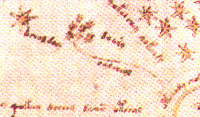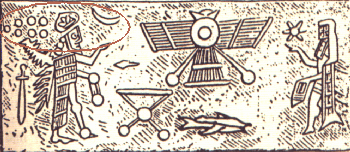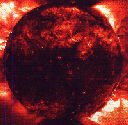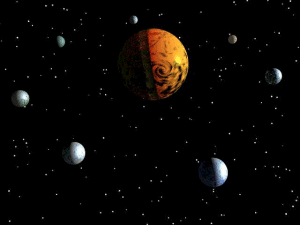
The Dogon Tribe and Nibiru
Robert Temple’s ground-breaking book, “The Sirius Mystery”, looks in detail at the belief of the Dogon, an African tribe living in the Mali republic in the sub-Sahara, that Sirius is a binary star system.

This information is impossible to obtain without using modern telescopes. Not only that, but the figure of 50 years that they allegedly claim for the orbit of Sirius B around Sirius A is absolutely accurate. The Dogon claim that this ‘sacred knowledge’ was given them by a race of god-like extra-terrestrials that came to earth from the Sirius system itself.
Temple’s treatment of this material is thorough, and he draws upon a wealth of ancient mythology to show corroborating data throughout the ancient world (1). However, other scholars doubt the claims of the Dogon. They argue that the Dogon were fed this information when contact was first made with Westerners (2). As such, Temple’s scholarly work has been side-lined by the scientific establishment, unfairly in my opinion.

A lot is made of the elliptical symbolism used by the Dogon to describe their sacred tertiary star system. They clearly identify this system as Sirius. Let us suppose that they have a long religious tradition, dating back to their Egyptian roots, then imparted through Greek migratory patterns. This tradition did indeed describe Sirius and this elliptical binary star system, but the Dogon were already separated from mainstream civilisation during the period we are interested in, namely the 1st century AD.
They, like the Middle Eastern world, watched the heliacal setting and rising of Sirius each year, in the hope of seeing the appearance of the binary dark star, Nibiru. During the first century AD, it appeared, as promised. They watched the red star appear near Sirius, and possibly watched some of its motion through the constellation of Canis Major. The perihelion passage was marred visually for the Dogon, just as it was for the Romans, Egyptians and Mesopotamians. The sense of the motion having occurred around the Sun was thus lost.
It is easy to see how the Dogon would attribute the star’s appearance to Sirius the Sirius system itself: the red star appears near Sirius, moves across it and disappears. To the Dogon, the ‘Nommo star’ must have appeared to move along its elliptical orbit, brightening whilst coming towards us, and than receding back to Sirius. The tradition of the Sirius system as being the home of the gods would have been visibly played out in the heavens for the Dogon observers.
A piercing bright red star appeared near Sirius in 25AD and the seemed to move around it before again disappearing. The Dogon, disconnected from the rest of the civilised world, interpreted this star as that of the Nommo, and thus believed that they had seen the invisible companion of Sirius appear in the sky.
In her review of Temple’s material, d’Arc summarises aspects of his research that finds relevance to this argument:
“The Dogon are aware that “an infinite number of stars and spiralling worlds exist” and that all types of creatures live on other “Earths”. In addition, they say that the Nommo, the people who come to Earth in their spaceships, will come back again when their ‘star’ appears in the heavens as “testament to the Nommo’s resurrection”. (3)
The Dogon also say that the third star in the system will appear to us, a star that may actually turn out to be a brown dwarf. This faint, red star could not hope to ever be seen from the Earth, however. So did the Dogon seen Nibiru and thought that they were seeing the ‘star of the Nommo’? Is this inconsistent with their knowledge of the Sirius system, or does this explain further pieces of the puzzle?

What is stunning about this Dogon oral tradition is how it was not stamped out by the various xenophobic purges of the following 2000 years. It retains the knowledge of an elliptical, binary star system, with the lesser star being tiny, but heavy, as is the white dwarf Sirius B. It includes slightly confusing information about a third tiny ‘star’, which the Dogon say will appear in our skies.
The appearance of the Nommo’s star is connected with a return to the Earth of the ‘monitor of the Universe’, which is very similar to the idea of the Nefilim, or Watchers. The problem is that the Dogon claim that the Nommo originate from the Sirius system, yet appear on the Earth with a visible star in the sky. Temple has quite reasonably interpreted this as a spaceship appearing from Sirius.
But there is another possibility.
Sol’s passage through the Orion Molecular Cloud
Our Sun is moving in the direction of the Solar Apex, an area of the sky near the bright northern star Vega. The stars in the Sun’s vicinity circle the galactic core, as does the Sun, in an undulating motion similar to a carousel horse. But the current direction of the Sun is a little ‘peculiar’, as discussed by Graham Hancock in ‘The Mars Mystery’:
“Superimposed on the Sun’s predominantly circular (albeit up-and-down) trajectory about the galactic nucleus there is also what astronomers refer to as the ‘peculiar’ solar velocity: ‘This direction…lies…roughly halfway between the bright stars Vega and Ras Alhaque, almost exactly opposite the molecular clouds in Orion.’” (4)
The angle of direction with respect to the galactic plane is 30 degrees. There’s that figure again, so important to the Egyptians (the angle of latitude of the necropolis at Giza) and the Sumerians (the Way of Anu). Hancock continues:
“Moreover, this place in the galaxy towards which the Sun is vectored is located opposite the molecular clouds of the Orion nebula…Lying in a region of space through which the Sun and the Earth are estimated to have passed roughly 5 to 10 million years ago, it forms the feature of the Orion constellation, beneath the belt stars…which the ancient Egyptians saw as the phallus of Osiris, the god of rebirth.” (4)
This area of the sky also takes in Sirius and the Pleiades, the star cluster known as the Seven Sisters. Robert Temple has identified Sirius as the place of origin of the Nommo, and the Pleiades is recognised as a source of intergalactic travellers by modern Ufological lore, despite the relative youth of these stars. This seems to be an important area of the sky as far as extra-terrestrial visitors to our planet are concerned.
Intriguingly, in Hope’s review of Temple’s theory she notes that the Dogon believe that their Siriun benefactors will one day return, and that their ‘star’ will again appear in the sky:
“It is not surprising to find the same belief among Dogon tradition – that their Siriun visitors will one day return – a ‘certain star’ will once more appear in the sky and will be a testament to the Nommo’s resurrection.” (5)
Temple and Hope consider the Dogon drawings of the Nommo vessel, in the form of a luminous circle, to be a spacecraft descending in a whirling pattern to Earth. But an alternative interpretation is that these pictures actually represent Nibiru as it appeared to the Dogon, and everyone else, roughly 2000 years ago. This would tie in better with Hope’s reference to a ‘certain star’ appearing in the sky, especially when taken in the context of the Nommo resurrection. This train of thought may indicate a connection between the Anunnaki of the Nibiru system and the Oannes of the Sirius system.
Is it possible that the Anunnaki originate from the latter, before colonising the former? In other words, the Anunnaki were originally space-farers from Sirius before settling the Nibiru system, and thence onto Earth. Could this explain the bizarre astronomical data contained within the enigmatic mediaeval Voynich Manuscript? (6,7) This might go a long way towards explaining the confused muddle that these ancient myths represent.

This page from the Voynich Manuscript seems to portray an orbital trajectory between a cluster of 7 small stars and the Sun. Are these the Pleiades, or a Dark Star reference, similar to the Talisman of Orpheus?

Close-up of the orbital trajectory, a celestial reference that mystifies those who have tried to decipher the Voynich Manuscript's code.

The above cylinder seal also comtains the same 7 stars imagery with the upturned crescent, in the context of the Nommo/Oannes figure, and the Age of Pisces! Does this signify the future return of Nibiru and its moons during the time of Christ?
Sirius C
Robert Temple’s theory about extra-terrestrial visitors, who gave civilisation to the ancients, proposes that Sirius has a second companion. The Dogon tribe have described this 3rd Siriun ‘star’ as the ‘Sun of Women’, and they represent it as a cross (1). In turn, it has a companion known as the ‘Star of Women’. Temple has outlined the attempts to verify that a second dwarf star belongs to the Sirius system:
“But evidence has now been found of the kind of Sirius C suggested by the Dogon. And such a discovery having been made, it conclusively establishes the validity of the Dogon claims. The Dogon information about the actual orbit of Sirius C is very confused and incoherent, apparently contradictory.” (1)
Over the years, it has been unclear whether astronomers think that Sirius does indeed have two companion dwarf stars, as the evidence to suggest this has been fleeting and controversial. New evidence seems to suggest that Temple is right, and that Sirius C, if it exists at all, could only be a brown dwarf:
“Many direct or indirect observations have suggested the existence of a second companion (in addition to the white dwarf Sirius-B) around the brilliant star Sirius-A. The presence of a second faint star could explain a change of color of Sirius, as suggested by historical texts. A team of astronomers of the CEA (Service of Astrophysics) and of Observatoire de Paris (IMCCE and DESPA) have recently obtained a new image of the sky around Sirius, using a coronographic device.
The new observations lead the authors to the conclusion that only a brown dwarf, similar to the weakest currently observed, with a magnitude of 18-19, could still be an undetected companion in the observed field. Also, the most central area (< 30 arcsec) around Sirius remains for the moment unexplored. A program is currently underway with ESO to observe the area nearest to Sirius with high spatial resolution using adaptive optics.
Among all the binary stars comprising a white dwarf, Sirius is a singular system; moreover, a different color has been reported in old historical texts. These characteristics, still largely unexplained, could well be the result of the evolution of a more complex system, comprising a third star still undetected.” (8,9)
This astronomical discovery could have far reaching repercussions for Temple’s theory. But the claims that it might also explain the ‘red Sirius’ anomaly are less likely to hold water. Whittet has shown that intrinsic factors within the Sirius system itself could not explain this anomaly, even if the second companion turns out to be a brown dwarf:
“A possible third component has been proposed from time to time by various authors. A conservative upper limit on the mass of the putative Sirius C is ~0.1M: such a low-mass object, should it exist, seems unlikely to have any direct relevance to the red Sirius anomaly.” (10)
Perhaps other astronomers would not agree with Whittet, and that the reddish light from the brown dwarf, moving in front of Sirius A, might have been sufficient to make the overall appearance of the Dog Star red. But this does not seem likely, especially considering how incredibly faint brown dwarfs actually are.

The author of the Unisci report is probably being over-optimistic. Indeed, Temple has told me that he has researched the ‘red Sirius’ anomaly at some length, and has concluded that it is a ‘red herring’. With respect to the proposed effect of Sirius C, as a brown dwarf, on the colour of Sirius, he seems to be right.
But that does not mean that something else is not going on, and I suggest that Nibiru’s conjunction with Sirius at perihelion is the missing part of the jigsaw.
A Tale of Two Brown Dwarfs
If the Nommo’s star is Sirius C, that appears to have been confirmed recently as a brown dwarf, then it seems logical to assume that their homeworld is the planet that orbits it, that the Dogon refer to as the ‘star of women’. If the Anunnaki decided to colonise the Solar system as it passed through the region of space dominated by Sirius and the Orion molecular cloud millions of years ago, then they would have sought out a world that was the most similar to their own. That would preferably not be a world orbiting in close proximity to our Sun, as this world would be much brighter than one circling a brown dwarf.

But the Solar system has a brown dwarf, according to the Dark Star Theory. Would they not prefer to colonise a planet that was a ‘home from home’, a planet itself orbiting a brown dwarf? A heavenly world in the outer Oort cloud? What do the Sumerians say about the origins of the Anunnaki? Actually, very little. Sitchin discusses the evolution of the Anunnaki race on Nibiru (11). In an interview Sitchin gave to d’Arc, he promoted the idea that life on Earth had been seeded by Nibiru, and that evolution had run in parallel on both planets (or systems, as I would prefer) (3).
But this doesn’t necessarily provide evidence that the Anunnaki originate from the Nibiru system, and Sitchin’s assertion that the Sumerians alluded to evolution is in fact a rather vague reference. The heavenly world in the Nibiru system might indeed by their home, but it needn’t be where they originated from.
It seems to me that this provides an explanation as to why the Nommo star should appear in our skies, whilst being consistent with the belief that the Nommo originate from Sirius. Our solar system has been colonised by them, and they chose a warm and relatively dark world that was orbiting a brown dwarf in the outer reaches of our star system. This Nibiruan moon had the same conditions on it as their own home planet orbiting around the brown dwarf Sirius C.
Unfortunately for these colonists from Sirius, the brown dwarf Nibiru was not to remain in its slow circular orbit around the Sun, but would be pulled into an elliptical comet-like orbit. I will be providing evidence for this in future postings on the Dark Star Theory site, based on computer simulation data of Nibiru's effects on the planetary solar system. It seems that the great circular orbit of Nibiru was perturbed millions of years ago, either by the closer position of the Sirius system, or the gigantic molecular clouds of Orion.
Either way, Nibiru moved from its unstable circular orbit of the Sun into a cometary orbit. This crisis brought the Anunnaki to our own planet in an attempt to solve the environmental problems that their adopted world was now experiencing. Problems brought about by the sudden close transitions through the planetary solar system. In turn, the new cometary orbit altered the Earth's orbital parameters enough to plunge it into a new Ice Age. The binding energy of our planet's orbit appears to be inextricably linked to the rather unstable orbital behaviour of the dark star Nibiru, home of the Nommo.
The Zulu Star Mu-sho-sho-no-no
Here's a quote from a Zulu elder about an anomalous Star with a great tail that turned the world upside down thousands of years ago:
"Let me tell you two last things please. One, it is this, that I am told by the great storytellers of our tribes, that fresh water is not native to our earth. That at one time, many thousands of years ago a terrible star, or the kind called Mu-sho-sho-no-no, the star with a very long tail, descended very close upon our skies. It came so close that the earth turned upside down and what had become the sky became down, and what was the heavens became up.
"The whole world was turned upside down. The sun rose in the south and set in the north. Then came drops of burning black stuff, like molten tar, which burned every living thing on earth that could not escape. After that came a terrible deluge of water accompanied by winds so great that they blew whole mountaintops away. And after that came huge chunks of ice bigger than any mountain and the whole world was covered with ice for many generations.
"After that the surviving people saw an amazing sight. They saw rivers and streams of water that they could drink, and they saw that some of the fishes that escaped from the sea were now living in these rivers. That is the great story of our forefathers. And we are told that this thing is going to happen again very soon. Because the great star, which is the lava of our sun, is going to return on the day of the year of the red bull, which is the year 2012."
(12)These are the words of Credo Mutwa, a spiritual leader of the Zulu people. It seems unlikely that such an event could have occurred as a result of a comet passage. Furthermore, the 'great star' is called the 'lava of the sun', which indicates a fiery countenance, which is also not in keeping with a comet's appearance. Is this great red star Nibiru?
Written by Andy Lloyd, 1st-2nd January 2001
author of 'The Dark Star' (2005), 'Ezekiel One' (2009), 'The Followers of Horus' (2010) and 'Darker Stars' (2019)
Published by Timeless Voyager Press
References
1) Robert Temple “The Sirius Mystery: New Scientific Evidence of Alien Contact 5,000 Years Ago” p328-330, 77, Century 1976
2) Kenneth Brecher & Michael Feirtag (Eds) "Astronomy of the Ancients" p112 MIT Press 1979
3) Joan d’Arc “Space Travellers and the Genesis of the Human Form: Evidence of Intelligent Contact in the Solar System” pp136-7, 193-4 The Book Tree 2000
![]() Space Travelers and the Genesis of the Human Form
Space Travelers and the Genesis of the Human Form
4) Graham Hancock, R. Bauval & J. Grigsby “The Mars Mystery: The Secret Connection Between Earth and the Red Planet ” p274-5, Penguin 1998
5) Murry Hope “The Sirius Connection: Unlocking the Secrets of Ancient Egypt ” p68 Element Books 1996
6) ‘Serp’ “Seven Sisters”
7) B. Schaefer “The Most Mysterious Astronomical Manuscript”, Sky & Telescope, 100(5): pp40-43, November 2000
8) “Any Sirius Second Companion Can Only Be Brown Dwarf” UniSci, 27 November 2000, thanks to Roel Wolfert
9) J. M. Bonnet-Bidaud, F. Colas, J. Lecacheux "Search for companions around Sirius", Astronomy & Astrophysics 360, 991, Nov 2000
10) D. Whittet “A Physical Interpretation of the ‘Red Sirius’ Anomaly” Mon. Not. R. Astron. Soc., 310(2): 355-359, December 1999
academic.oup.com/mnras article
11) Zecharia Sitchin “When Time Began” p10, Avon, 1993
12) C. Mutwa, Keynote Address, Livin Lakes Conference 2 October 1999 (No longer available online)